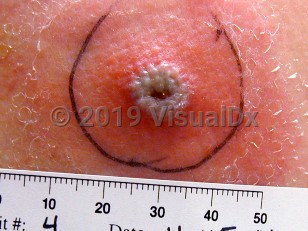Vaccinia vaccination normal reaction - Smallpox Vaccination
Alerts and Notices
Important News & Links
Synopsis

Vaccinia virus is a member of the genus Orthopoxvirus; others include smallpox (variola), mpox, camelpox, etc. When administered as a dermal vaccine, the immune reaction to the live vaccinia virus produces protection against smallpox. Both antibody and cell-mediated immunity result from a "take" (ie, successful vaccination). A normal reaction to a first-time (primary) smallpox vaccination follows a traditional sequence of lesions over the 2-3 weeks. Rarely, seemingly appropriate vaccination techniques may result in a "non-take" (ie, no reaction).
Systemic symptoms to primary vaccination are expected and usually occur about a week after vaccination. These include soreness at the vaccination site, intense erythema ringing the site, malaise, local lymphadenopathy, myalgia, headache, chills, nausea, fatigue, and fever. Normal reactions that are not considered adverse events can also include local satellite lesions that are normal in appearance, lymphangitis, considerable local edema, and what appears to be bacterial cellulitis but is simply attendant intense inflammation accompanying the vaccination. Splenomegaly has been observed during this period signifying systemic viremic or toxic effect, but this is a normal reaction.
A normal reaction to revaccination may present as a non-take, a diminished and more rapidly progressing take, or a normal primary take. Some vaccinators have observed an "allergic" reaction in immune individuals consisting solely of erythema and a small evanescent papule that present within the first week that resolve quickly. Experienced observers believe these are "sensitivity" reactions and do not necessarily imply immunity.
A non-take may be due to poor technique, inactive or low potency vaccine, or inactivation of the virus at the skin site (eg, if alcohol is used to prepare the site). If the threat of exposure to smallpox is high, then at least two more attempts should be made, shifting sites of vaccination after two unsuccessful attempts. If the individual never has a successful take, he/she must be informed that they are most likely NOT immune.
Systemic symptoms to primary vaccination are expected and usually occur about a week after vaccination. These include soreness at the vaccination site, intense erythema ringing the site, malaise, local lymphadenopathy, myalgia, headache, chills, nausea, fatigue, and fever. Normal reactions that are not considered adverse events can also include local satellite lesions that are normal in appearance, lymphangitis, considerable local edema, and what appears to be bacterial cellulitis but is simply attendant intense inflammation accompanying the vaccination. Splenomegaly has been observed during this period signifying systemic viremic or toxic effect, but this is a normal reaction.
A normal reaction to revaccination may present as a non-take, a diminished and more rapidly progressing take, or a normal primary take. Some vaccinators have observed an "allergic" reaction in immune individuals consisting solely of erythema and a small evanescent papule that present within the first week that resolve quickly. Experienced observers believe these are "sensitivity" reactions and do not necessarily imply immunity.
A non-take may be due to poor technique, inactive or low potency vaccine, or inactivation of the virus at the skin site (eg, if alcohol is used to prepare the site). If the threat of exposure to smallpox is high, then at least two more attempts should be made, shifting sites of vaccination after two unsuccessful attempts. If the individual never has a successful take, he/she must be informed that they are most likely NOT immune.
Codes
ICD10CM:
– Normal Condition -- no billing code
– Normal Condition -- no billing code
Look For
Subscription Required
Diagnostic Pearls
Subscription Required
Differential Diagnosis & Pitfalls

To perform a comparison, select diagnoses from the classic differential
Subscription Required
Best Tests
Subscription Required
Management Pearls
Subscription Required
Therapy
Subscription Required
References
Subscription Required
Last Updated:09/25/2023

